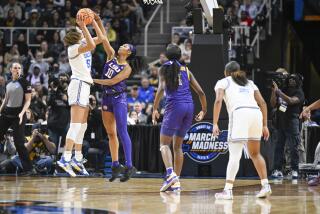New Comic Steps Into the Racial Divide
Does “The Boondocks,” a new comic strip featuring black characters and written and drawn by a black artist, succeed in exploring racial issues--or is it just racist? Since The Times introduced the strip April 19, about 250 readers have telephoned or written to comment. Many passionately criticize it as racist and accuse it of promoting violence and negative stereotypes of African Americans. But an almost equal number say the strip portrays their lives accurately and with humor and critically exposes stereotypes. Readers on both sides threaten to cancel their subscriptions if The Times continues to run--or drops--it.
“The Boondocks” deals with the everyday lives of several black children who have moved from the inner city to mostly white suburbia. There’s Huey, who is a black nationalist with a scholarly bent named after Black Panther Huey Newton, his gangsta wannabe younger brother, Riley, and Jazmine, a biracial neighbor struggling with her identity.
The June 4 strip generated the most negative response. It featured a little white girl who was knocked down when Riley hit her on the head with a toy light saber. Standing over her, he says, “See?! You’re still alive! This thing is worthless!’
“You’re showing black kids it’s all right to attack whites. This is disgusting,” said one caller. One reader said of earlier strips, “It’s very offensive to me as an African American woman. It’s terrible! It makes black people look like demons. I can’t stand it!” Said another, “This strip seems to celebrate the worst image of young African Americans as ignorant gang-bangers-in-training who take pride in striking fear in others.” Many who complained shared the thoughts of a reader who said the strip “is truly offensive in a city that has struggled so hard to overcome racial division.”
Supporters disagree. An e-mailer wrote: “It makes us take a look at the whole stupidly ridiculous way we view race here in America . . . It does my head and heart good to have [my stereotypes] put in the spotlight and laughed about.” Another said, “I think the strip brings a keen insight and wonderfully subtle humor to issues that not enough people talk about to each other.” A third noted, “He must be stepping on many toes with his right-on remarks about race and class.” One put it simply: “It makes me think.”
Creator Aaron McGruder makes his own case on his Web site (https://www.boondocks.net): “I care nothing about tearing down stereotypes . . . I only want to represent truth, inspire thought and make people laugh.”
Upcoming strips, however, reflect the controversy and are milder.
The comic strip had an extraordinary launch--174 newspapers in the U.S. and abroad and 22 Internet sites. Since then, responding to complaints, one newspaper canceled it, and one moved it off the comics page. Others, including The Times, continue to evaluate it. The question is whether an edgy commentary on race belongs on the comics pages, where the form is caricature. The answer is yes, unless it slips from satire to malice.
When “The Boondocks” was offered to The Times by Universal Press Syndicate, John P. Lindsay, managing editor for features, asked a dozen people to assess it for Editor Michael Parks, who has the final say, “because it looked like it might generate controversy.” Lindsay asks various staff members to evaluate new strips and also consider which to drop. He noted that the popular, now-retired strip “Calvin and Hobbes” was violent “but if [Calvin] had been black, you would’ve heard about it . . . it’s interesting that people find it acceptable for Calvin to be violent and mean, and then Huey comes along and he’s black and not acceptable.”
In years past, comic strips openly ridiculed racial and ethnic minorities in ways that would be unacceptable today. Several famous strips generated controversy. In the 1950s, Walt Kelly caricatured Sen. Joseph McCarthy as the “Pogo” character Simple J. Malarkey; readers protested and some papers canceled. “Lil’ Abner” and “Dick Tracy” offended some readers and editors due to political views and violence. Female readers complained about the alcoholic, wife-abusing character Andy Capp in that long-running strip and of sexist treatment of the well-endowed Miss Buxley in “Beetle Bailey.” When The Times dropped those strips, many fans complained. (The Times dropped “Love Is . . . “ in December but restored it after a week--and 1,300 complaints.)
“Doonesbury” has been yanked--to many readers’ dismay--when Times editors felt creator Garry Trudeau could be libeling some public figures. When Lynn Johnston introduced an openly gay character in “For Better or For Worse,” readers around the country--though less so in Southern California--inundated editors with complaints. Clearly, comic strips strike a nerve. They’ve become an important arena for social commentary and arguably influence attitudes. Maybe that’s what fans of “The Boondocks” most hope for--and what its opponents most fear.
To reach the readers’ representative, call (877) 554-4000; fax: (213) 237-3535; e-mail: readers.rep@latimes.com; mail: Times Mirror Square, L.A. 90053.
More to Read
The biggest entertainment stories
Get our big stories about Hollywood, film, television, music, arts, culture and more right in your inbox as soon as they publish.
You may occasionally receive promotional content from the Los Angeles Times.










